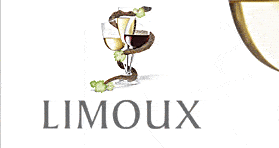 This week sees another big wine trade bash at VINISUD, which is a held in Montpellier and focuses on Mediterranean wines, and not just French. Going by the number of invites I have received (and regretably had to decline) the show just keeps getting bigger, and that is a good sign that quality levels are continuing to rise.
This week sees another big wine trade bash at VINISUD, which is a held in Montpellier and focuses on Mediterranean wines, and not just French. Going by the number of invites I have received (and regretably had to decline) the show just keeps getting bigger, and that is a good sign that quality levels are continuing to rise.
One of the appellations represented is that of Limoux – well, really it is 4 appellations, just to confuse matters. Situated south of Carcassonne (11 Aude, Languedoc) in the heart of Cathar country, the town itself is not one of the prettiest. And some of the cellars also seem a little industrial. But on the many and varied slopes around the town, vines produce wines which are often little understood and less appreciated.
Firstly and foremost is the Blanquette de Limoux AC. This claims to be the first sparkling wine produced in the world in 1531 by the Benedictine monks at the Abbaye de Saint-Hilaire. “Blanquette” comes from the Mauzac grape, which develops a white down on the vineleaves – hence “blanc” or white. Mauzac is also used in Gaillac. Up to 10% of Chenin Blanc (the Loire grape) and the ubiquitous Chardonnay may be added. Made using the “methode champenoise” and undergoes a secondary fermentation in bottle before final bottling at 9 months.The resulting wine is fresh and dry with a pleasant “yeasty” edge.
Next comes the Blanquette de Limoux Methode Ancestrale AC where the wine is bottled whilst it still contains yeast and unfermented sugars – so that as the sugar ferments the bubbles develop in the bottle. This tends to be a sweeter wine with relatively low alcohol.
Just to confuse matters there is a third sparkling wine – Cremant de Limoux AC where the blend is predominantly Chardonnay and Chenin Blanc, and the wine is matured on its lees for 12 months before final bottling – again made by the Champagne method.The Chardonnay and Chenin produce more familiar and rounded flavours with a good mousse.
Finally there are the still wines of Limoux AC – The White Limoux is made from Chardonnay, Mauzac (15% minimum) or Chenin Blanc whilst the Red Limoux are composed of at least 50% Merlot; at least 30% of Côt (Malbec), Syrah and Grenache and a maximum of 10% Carignan. They can already also have up to 20 % of Cabernet-Franc and Cabernet-Sauvignon.
It has to be said that with this mix of grapes allowed it is obviously possible to produce some good interesting wines, but I suspect it may be difficult to identify a particular style, especially for the still, red Limoux. The best offering is to my mind the Blanquette de Limoux, which is usually interestingly different from the normal cheaper fizz, which is likely to be a more consistent style given the requirement for including 90% Mauzac.
My personal favourite producer is Antech, and not just because a most memorable family lunch I enjoyed their many years ago. Although I liked their wines I was not brave enough to import such little-known wines – but Michael and Patricia Robertson at Devignewines and Confit Direct in North Berwick have! We’ll be looking at their list of goodies again soon.
If you are in the region of Limoux we can recommend a good English-run B&B at Les Eaux Tranquilles at Quillan – very reasonable, very comfortable rooms and superb setting by the fast-running Aude river – other hotels, B&Bs and self-catering in and around Limoux
Also see our calendar of events in France
Keywords:france,wine,limoux,cremant,carcassonne,aude,blanquette,quillan
Discover more from FrenchDuck.com
Subscribe to get the latest posts sent to your email.